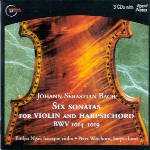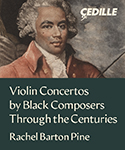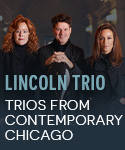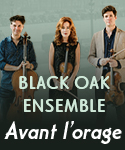What struck me immediately listening to these new Musica Omnia recordings of J.S. Bach’s familiar sonatas for violin and harpsichord is how similar they sounded to one of my longstnding favorite cycles, the long-deleted Philips recording with Monica Huggett and Ton Koopman. Like Huggett and Koopman, violinist Emlyn Ngai and harpsichordist Peter Watchorn’s performances share a similar swagger, panache, and emphasis on the dance. The differences between their tempo timings in most movements are also only within 10 and 20 seconds of one another (no one compares with Huggett’s fleet bravura in the faster movements). The most remarkable similarity between the two cycles however, is the way they sound: both the violin and harpsichord are afforded a stunning equal sonic weight and presence. When the Philips cycle was first issued, this acoustic equality often was criticized as being too up-front and unrealistic. To my ears though, this balance made wonderfully refreshing musical sense.
Watchorn feels the same way, explaining in his copious notes that the successful performance of these pieces depends on this sonic relationship between the instruments. He posits that the harpsichordist’s right hand often is the equal partner with the violin, while the left hand supplies the bass line usually provided by a cello or viola da gamba. He further explains how difficult this balance is to achieve in live performance (or recorded for that matter, regardless of how closely each instrument is miked), the key being how well the instruments are matched. Like Koopman, Watchorn has selected an ample harpsichord capable of this desired dynamic equilibrium. And also like the regrettably deleted Philips set, this Musica Omnia recording auspiciously succeeds on a sonic level that only a handful of currently available recordings do.
Unlike any other recording, Musica Omnia offers a free third CD titled “Bach as Kapellmeister”. Here Watchorn discusses the circumstances in which Bach composed these sonatas, often supplementing his commentary with musical examples. I’m told that Musica Omnia plans to include a similar offering (called “Beyond the Notes”) with every future release.
Bach’s milestone oeuvre for violin and harpsichord has certainly had its share of wonderful recordings, and to choose an absolute favorite would be an unfair if not impossible expectation given the variety and diversity of interpretations. Of the currently available recordings, Kuijken/Leonhardt and Goebel/Hill, along with Manze/Egarr/Linden and Grumiaux/Jaccottet/Mermoud (who solve the left-hand bass line difficulty by simply adding a gamba) are unique cycles worthy of consideration. Add Ngai and Watchorn to the list, especially if instrumental perspective and sheer naturalness of sound is a priority. Highly recommended!
































